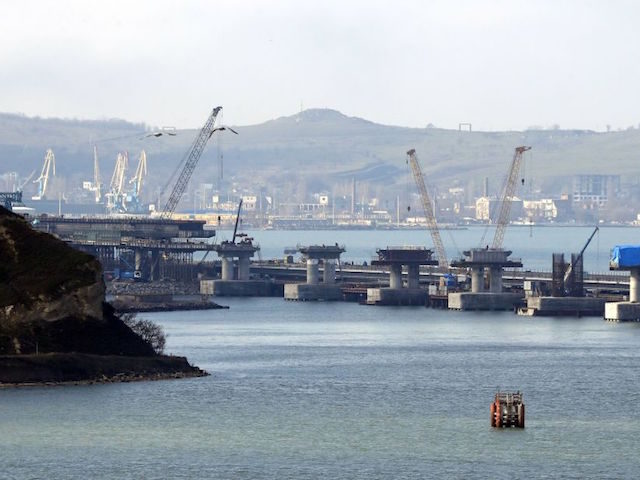This morning’s key headlines from GenerationalDynamics.com
- Russia’s actions in Sea of Azov raise fears of another invasion of Ukraine
- Ukraine’s Donbas war continues, as US supplies Javelin anti-tank missiles
Russia’s actions in Sea of Azov raise fears of another invasion of Ukraine

Ukraine. In 2014, Russia invaded and occupied Donbas and invaded and annexed Crimea. In 2018, Russia completed a bridge over the Kerch Strait, controlling access to the Sea of Azov.
The Russian navy in recent weeks has boosted its presence in the Sea of Azov to approximately 40 ships, giving it the ability to control that body of water and to strike virtually at will along Ukraine’s coastline there. This is the latest in a series of Russian threats and acts of harassment directed at crippling Ukraine’s economy, and possibly preparing for new military actions.
Ever since 2014, when Russia invaded and occupied eastern Ukraine (Donbas), and then invaded and annexed Ukraine’s Crimea peninsula, there have been continuing fears that Russia would launch a new invasion and annex another portion of Ukraine.
It has been thought that the most likely target of a new Russian invasion would be the port cities of Mariupol, Berdyansk, and the entire strip of land along the Sea of Azov connecting Russia to Crimea, creating a land bridge from Russia to Crimea and taking total control of the Sea of Azov.
No such invasion has occurred, but starting in May 2015, Russia began constructing an 11.8-mile bridge across the Kerch Strait, from Russia to Crimea, to allow transport of goods and people between Russia and Crimea, and also to control access to the Sea of Azov. The construction of the bridge immediately had a severe effect on Ukraine’s economy. Russia several times closed the Kerch Strait to maritime traffic, trapping commercial vessels docked in Mariupol and Berdyansk seaports. During 2017, freight traffic was reduced 43 percent and transshipments shrank by 30 percent, totaling $54 million in 2017.
The Kerch Strait bridge officially opened on May 16, a year earlier than initially announced. Many vessels that used to deliver goods to Azov seaports can no longer do so at all because the Russians have deliberately made the passageways under the bridge too small for many vessels. The Russians have all but blocked the Ukrainian seaports on the Sea of Azov, stopping international vessels from shipping goods to and from Ukrainian cities. Russia’s security forces stop and search dozens of vessels, and delay them for days. In the four days last week from July 2-5, Russia’s security forces detained seven cases. Jamestown and Hromadske (Ukraine) and Eurasia Review and Maritime Bulletin and Jamestown
Ukraine’s Donbas war continues, as U.S. supplies Javelin anti-tank missiles

In Kiev, a metal silhouette of a girl with a balloon, dotted with bullet holes, a reminder of the war in Donbas. (Getty)
The war in Ukraine began in 2014 when Russian troops invaded eastern Ukraine, a region known as the Donbas. The war is entering its fifth year with no end in sight. More than 10,000 people have been killed, including 2,800 civilians. Nearly two million people have been internally displaced or put at risk if they remain in their homes.
Because of a fear of a further major Russian military invasion, the Donald Trump administration last year approved the sale of Javelin anti-tank missile systems. A $47 million U.S. military-aid package approved last year specified 210 Javelin antitank missiles and 37 Javelin launchers, two of them spares. Ukraine announced on April 30 that they had been delivered.
The missiles are to be used only for defensive purposes. According to a U.S. statement at the time of the sale last year:
This proposed sale will contribute to the foreign policy and national security of the United States by improving the security of Ukraine.
The Javelin system will help Ukraine build its long-term defense capacity to defend its sovereignty and territorial integrity in order to meet its national defense requirements. Ukraine will have no difficulty absorbing this system into its armed forces.
The proposed sale of this equipment and support will not alter the basic military balance in the region.
The U.S.-made FGM-148 Javelin is a fire-and-forget anti-tank missile that uses infrared guidance to hit armored targets. The guidance system is contrasted to wire-guided anti-tank missiles, which require a shooter to actively guide the weapon until it hits its target. A Javelin shooter can immediately seek cover after firing its shot.
Russia’s foreign ministry reacted to the sale by accusing the United States of “fomenting a war.” Such statements from Russia are always laughable since Russia has absolutely no credibility. Russia invaded Ukraine and annexed Crimea, lying about it every step of the way, and continually supplied weapons to the forces in the Donbas. In particular, it was a Russian-made Buk missile that shot down the Malaysian Airlines passenger plane in July 2014, killing hundreds of passengers. Washington Post and RFE/RL and Newsweek and Defense News
Related Articles:
- Ukraine seizes Russian ship in Sea of Azov in retaliation for Kerch Strait blockade (06-Apr-2018)
- Fears grow that a new Russian invasion of Ukraine is imminent (12-Aug-2016)
- Dutch report confirms that Russian missile shot down airliner over Ukraine (14-Oct-2015)
- BBC reporters attacked by Russian thugs after finding evidence of new Ukraine invasion (19-Sep-2014)
- Russia’s sophisticated disinformation campaign over Ukraine (15-Aug-2014)
KEYS: Generational Dynamics, Ukraine, Russia, Donbas, Crimea, Kerch Strait, Sea of Azov, Mariupol, Berdyansk
Permanent web link to this article
Receive daily World View columns by e-mail

COMMENTS
Please let us know if you're having issues with commenting.